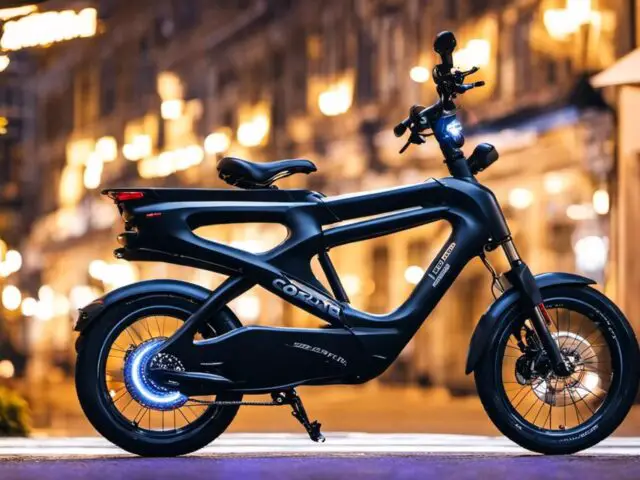As our society becomes increasingly aware of the impact of our actions on the environment, more and more people are seeking out eco-friendly alternatives in their daily lives. One area where we can make a significant difference is in our transportation choices. With the rise of electric vehicles and the popularity of biking, there are now more environmentally-friendly options available than ever before. In this blog post, we will explore the best eco-friendly transportation options, specifically focusing on the benefits of e-bikes.
Understanding Eco-Friendly Transportation
In today’s world, it’s essential that we take responsibility for the impact our choices have on the environment. Transportation is one area where we can make a significant difference. By choosing eco-friendly modes of transportation, we can reduce our carbon footprint and contribute to a cleaner, healthier planet.
But what exactly is eco-friendly transportation? Put simply, it refers to any mode of transportation that minimizes negative environmental impacts. This can include vehicles that use clean energy sources, like electric cars, or those that rely on human power, such as bicycles or walking. The goal is to find alternatives to traditional vehicles that burn fossil fuels and release harmful emissions into the atmosphere.
When we choose eco-friendly transportation options, we’re not only reducing our individual carbon footprint but also helping to combat climate change. Transportation is one of the largest contributors to greenhouse gas emissions, so by opting for greener modes of travel, we can actively contribute to reducing the amount of carbon dioxide released into the atmosphere.
Additionally, eco-friendly transportation has other benefits beyond just the environmental aspect. It can also improve air quality, reduce traffic congestion, and promote healthier lifestyles. Choosing to walk or bike instead of driving not only helps the planet but also provides a great opportunity for exercise and personal well-being.
Understanding eco-friendly transportation is the first step in making informed choices that benefit both ourselves and the environment. By choosing alternatives that prioritize sustainability, we can create a greener future for ourselves and generations to come.

Exploring E-Bikes as a Sustainable Transportation Option
As we continue our journey towards a greener future, it’s important to explore the various eco-friendly transportation options available to us. One option that has gained significant popularity in recent years is the electric bike, or e-bike for short. E-bikes are an innovative and sustainable mode of transportation that offer numerous benefits for both individuals and the environment.
So, what exactly is an e-bike? It’s essentially a bicycle equipped with an electric motor and a battery that provides pedal-assist or full-electric power. This means that riders can choose to pedal like a traditional bike, use the motor for assistance while pedaling, or rely entirely on electric power. The versatility of e-bikes makes them suitable for various terrain, fitness levels, and commuting distances.
One of the most significant advantages of e-bikes is their ability to reduce carbon emissions. By using electric power instead of relying solely on gasoline or diesel fuel, e-bikes have a significantly lower environmental impact compared to traditional vehicles. They emit zero tailpipe emissions, making them a clean and eco-friendly alternative for short commutes or leisurely rides.
In addition to being environmentally friendly, e-bikes also offer several practical benefits. They can save you money on fuel costs and parking fees, as they require minimal maintenance and don’t require insurance or registration. E-bikes can also help improve your physical fitness and overall well-being, as the pedal-assist function encourages regular exercise without putting too much strain on your joints.
E-bikes contribute to reducing traffic congestion in urban areas. With their ability to navigate through congested streets and bypass traffic jams, e-bikes provide a more efficient and time-saving alternative to traditional transportation methods. By choosing an e-bike for your daily commute, you not only save time but also reduce the overall traffic load on the roads, leading to smoother and more sustainable transportation for everyone.
Other Green Modes of Transportation
In addition to e-bikes, there are several other green modes of transportation that are worth exploring for their eco-friendly benefits. One such option is public transportation. Using buses, trains, or trams instead of driving a personal vehicle can significantly reduce carbon emissions and alleviate traffic congestion. Public transportation is also a cost-effective option for daily commuting, as it eliminates the need for parking fees and fuel expenses.
Carpooling and ridesharing are also effective ways to reduce the number of vehicles on the road. By sharing rides with others, you not only reduce your individual carbon footprint but also save money on fuel costs. Carpooling and ridesharing platforms, such as UberPool (now UberXShare) and Lyft Line, make it easy to connect with other travelers heading in the same direction.
For shorter distances, walking and traditional biking are excellent alternatives to motorized transportation. Walking is not only eco-friendly but also a great way to stay active and improve your overall health. Biking, on the other hand, offers the added benefit of being faster than walking while still being environmentally friendly. Many cities now have bike-sharing programs, making it convenient for individuals to rent bicycles for their daily commutes or leisurely rides.
Electric Skateboards have made a significant rise as another eco-friendly transportation choice. From Onewheels to longboards, these eco conscious boards can create a smaller carbon footprint and help navigate congested urban traffic areas. The added benefit of electric skateboards is their portability, allowing you to take them almost anywhere with you.
For those living in urban areas, electric scooters are becoming increasingly popular. Electric scooters produce zero emissions and can be a fun and efficient mode of transportation for short distances. They are especially useful for navigating crowded streets and finding parking in busy areas. Most largely populated areas have scooter rental services such as Lime and Bird.
Here are some other more eco conscious choices that you can try for transportation.
| Eco-Friendly Mode of Transportation | Pros | Cons |
|---|---|---|
| Walking | Zero emissions, good for your health, free | Can be slow and impractical for long distances, requires good weather |
| Biking | Zero emissions, good for your health, relatively fast, can be fun | Can be impractical for long distances or carrying heavy loads, requires good weather |
| Public transportation | Relatively low emissions, efficient, can be affordable | Can be slow and crowded, may not be available in all areas |
| Electric vehicles | Low emissions, can be fast and convenient | Can be expensive, require access to charging stations |
| Carpooling | Lower emissions than driving alone, can be more social | Can be difficult to coordinate with others |
| Trains | Very low emissions, efficient, can be comfortable and relaxing | Can be slow, may not be available in all areas |
| Buses | Relatively low emissions, efficient, can be affordable | Can be slow and crowded, may not be available in all areas |
| Electric scooters and longboards | Zero emissions, portable, can be fun | Can be dangerous, may not be practical for long distances or carrying heavy loads |
| Electric bikes | Zero emissions, can be fast and convenient, can carry heavy loads | Can be expensive, require access to charging stations |
General tips for choosing an eco-friendly mode of transportation:
- Walk or bike whenever possible.
- Take public transportation when available.
- If you must drive, carpool or use an electric vehicle.
- Choose the most efficient mode of transportation for your trip.
- Avoid flying whenever possible.
Exploring these other green modes of transportation provides individuals with a range of options to choose from based on their needs and preferences. By incorporating these alternatives into our daily lives, we can contribute to a more sustainable and eco-friendly future.

The Positive Impacts of Eco-Friendly Transportation
Choosing eco-friendly transportation options can have a wide range of positive impacts on both the environment and our daily lives. By making the switch to greener modes of transportation, we can contribute to a healthier planet and create a more sustainable future for generations to come.
One of the most significant positive impacts of eco-friendly transportation is the reduction in greenhouse gas emissions. Traditional vehicles that run on fossil fuels contribute to the release of carbon dioxide and other harmful pollutants into the atmosphere, leading to climate change and air pollution. By choosing alternatives like e-bikes, public transportation, or walking, we can significantly reduce our carbon footprint and help combat these environmental issues.
In addition to reducing emissions, eco-friendly transportation options can also improve air quality. Vehicles that burn fossil fuels emit harmful pollutants that can have detrimental effects on our health. By opting for cleaner modes of transportation, we can help reduce the amount of pollutants in the air, leading to cleaner and healthier cities.
Another positive impact of eco-friendly transportation is the reduction in traffic congestion. By choosing options like biking, walking, or public transportation, we can help alleviate the burden on our roads and highways. This not only leads to smoother and more efficient transportation for everyone but also reduces the time spent sitting in traffic and the stress associated with it.
Eco-friendly transportation options also promote healthier lifestyles. Walking, biking, and even using public transportation require physical activity and can contribute to improved fitness levels and overall well-being. By incorporating these activities into our daily routines, we can enjoy the benefits of exercise while also reducing our impact on the environment.
Lastly, choosing eco-friendly transportation options can save us money. Vehicles that rely on fossil fuels are not only costly to operate but also require expenses like fuel, maintenance, insurance, and parking fees. By opting for greener alternatives, we can cut down on these costs and allocate our resources towards other priorities.
Making Your Transition to Green Transportation
Making the transition to green transportation is a commendable choice that not only benefits the environment but also enhances our quality of life. So, how can you make the switch to eco-friendly transportation? Here are some practical steps to help you get started on your journey towards greener commuting.
- Evaluate your current transportation habits: Take a moment to assess your current mode of transportation and the impact it has on the environment. Are there opportunities for improvement? Consider factors like distance, frequency, and feasibility of alternative options.
- Research eco-friendly transportation alternatives: Look into the different green transportation options available in your area. Whether it’s e-bikes, public transportation, carpooling, or walking, explore the options that align with your needs and preferences.
- Plan your routes: Map out your daily commute and identify the most efficient and eco-friendly routes. Consider factors like distance, traffic patterns, and the availability of bike lanes or public transportation options.
- Start small: Transitioning to green transportation doesn’t have to be an all-or-nothing approach. Begin by incorporating eco-friendly alternatives into your routine gradually. For example, you can choose to bike or walk for shorter distances or use public transportation a few times a week.
- Make it a lifestyle: Once you’ve embraced eco-friendly transportation options, make them a regular part of your lifestyle. Commit to reducing your reliance on traditional vehicles and prioritize sustainable alternatives.
- Advocate for change: Spread awareness about the benefits of green transportation within your community. Encourage others to make the switch and support initiatives that promote sustainable commuting options.
Remember, every small step counts towards creating a greener future. By making the transition to green transportation, you’re not only contributing to a cleaner environment but also leading a healthier and more sustainable lifestyle. So, let’s embark on this journey together and pave the way for a brighter and greener future.
Carbon Offsetting: A Tool to Enhance Your Eco-Friendly Commute
As we continue our journey towards a greener future, it’s essential to explore additional measures we can take to enhance our eco-friendly commuting choices. One effective tool in our arsenal is carbon offsetting. Carbon offsetting allows us to take responsibility for the emissions we produce by investing in projects that reduce greenhouse gas emissions elsewhere.
When we commute using eco-friendly transportation options like e-bikes, public transportation, or walking, we are already significantly reducing our carbon footprint. However, there are instances where using traditional vehicles or traveling long distances may be necessary. In these cases, carbon offsetting can help mitigate the environmental impact.
Carbon offsetting works by investing in projects that either reduce greenhouse gas emissions or remove carbon dioxide from the atmosphere. These projects can include reforestation initiatives, renewable energy projects, or methane capture programs. By purchasing carbon credits from these projects, we can offset the emissions produced during our commutes.
The process of carbon offsetting is simple. It involves calculating the carbon emissions generated by your commute, either through an online calculator or with the help of a carbon offsetting service. Once you have determined the emissions, you can purchase carbon credits equivalent to that amount. These credits support projects that reduce emissions, effectively balancing out the impact of your commute.
Carbon offsetting not only helps us compensate for unavoidable emissions but also supports the growth of sustainable initiatives around the world. It allows us to actively contribute to the fight against climate change and promote the transition to a low-carbon economy.
So, as you make the switch to eco-friendly transportation options, consider incorporating carbon offsetting into your commute. It’s a powerful tool that enhances your efforts towards a greener future. By embracing eco-friendly commuting and offsetting any residual emissions, we can create a sustainable and more environmentally-conscious society. Together, we can make a significant impact and pave the way for a cleaner, healthier planet.

The Future of Eco-Friendly Transportation
Eco-friendly transportation shows no signs of slowing down; quite the contrary, impressive leaps and bounds are being made every day in the name of our planet. What’s more, we can anticipate some wonderful advances in the near future.
For starters, one may want to look at shared mobility, specifically carpooling and ride-sharing services. As more people become aware of the dire need to reduce carbon footprints, these shared services are expected to flourish. From giants like Uber and Lyft to local community-based programs, the shared economy is primed to even lower emissions against the total passenger miles traveled.
Then there are green fleets, a fascinating development in the world of commerce and transportation. Companies are steadily transitioning to hybrid, electric, and energy-efficient vehicles for delivery and transport. This impressive push is indeed an applaudable shift and surely a significant stride towards achieving carbon neutrality.
Diving more into innovation, hydrogen fuel cell vehicles (FCVs) are the new kids on the block and are already making quite a splash. Powered by hydrogen and emitting only water, they are fast, have long ranges and can be refueled just as quickly as gasoline cars, making them a promise for the future. We can expect FCVs to become more accessible and affordable as technology improves.
What about good old human power? The resurgence of human-powered transportation, like rollerblading and walking, especially in urban areas, is an inspiring sight. Cities worldwide are recognizing the benefits of stress-free, low-cost, and highly eco-friendly transportation methods.
Technological advancements are the cornerstone of sustainability in transportation. Electric vehicle charging infrastructure, for instance, has remarkable potential for improvement. Faster, more accessible charge points, along with green electricity sourcing for these stations is an exciting prospect.
Lastly, it’s crucial to remember the power of personal choice in the fight for a greener future. Each decision to walk, cycle, carpool, or utilize public transportation can potentially add up to a significant decrease in emissions.
The advancements in eco-friendly transport, coupled with a willingness to change, have the potential to make a significant difference in protecting our planet. All aboard for the journey toward a more sustainable future!

As we navigate through the urgent challenges presented by climate change, eco-friendly transportation emerges as a critical beacon of hope. These sustainable solutions not only reaffirm our potential to dramatically reduce harmful emissions and preserve our precious resources but also present an economically viable option for the long term. What lies ahead is a fascinating and promising panorama: a world where shared autonomous electric cars rule the road, where solar energy powers our daily commute, and where the sky buzzes with emission-free flying taxis. In this exciting journey towards a sustainable future, eco-friendly transport remains not only a desirable choice but a necessary transition, with each of us playing an integral part in promoting and utilizing these green innovate solutions.
Helpful Links
For all your RC Questions, Click HERE
If you are interested in RC cars and trucks, RC World has you covered.
For RC boats and watercraft, check these articles out.
For all your RC Airborne endeavors, we have everything you need.
Selecting the Best Deck Material for Your E-Board
The allure of riding an electric skateboard is hard to ignore. Paving your way through streets and parks, feeling the breeze on your face, it’s a hobby that…
Best Deck Materials for Electric Skateboards
The world of electric skateboards is evolving at an impressive pace, with advancements in technology and design enhancing the riding experience every day. A critical component of this…
All You Need To Know About The Best RC Car Brands
If you are looking for an exciting hobby that will give you hours of excitement and thrilling heart pumping speed, in a small form factor, and right from…
10 Essential Electric Skateboard Safety Tips
Thrills and freedom – that’s what draws us to the surge of electric skateboards beneath our feet. But as enthusiasts and hobbyists alike can attest, power comes with…
RC Gearing 101: Ramping Acceleration or Top End Speed
There is nothing in this world that is more fun than having your RC car blasting through obstacles and around tracks at speeds you could barely think of….
Master Electric Skateboard Cruising
Glide into the electrifying world of portable electric skateboard cruising, an exhilarating hobby that combines the adrenaline rush of high-speed riding with the convenience of modern technology. As…
Why Electric Pedal-Assist Bikes Are a Game Changer
Electric pedal-assist bikes, often referred to as e-bikes, are a revolutionary mode of transportation that combines the benefits of traditional pedal power with an electric motor to provide…
Mastering Mountain E-bikes on Thrilling Trails
As technology continues to advance and become more ingrained into every aspect of our lives, it’s only logical that it also finds its way into our recreation. One…
Six Reasons to Ride a Fat Tire Electric Bike
In an era where practicality, health, and sustainability are at the forefront of our minds, the fat tire electric bike has emerged as an exhilarating solution to all…










